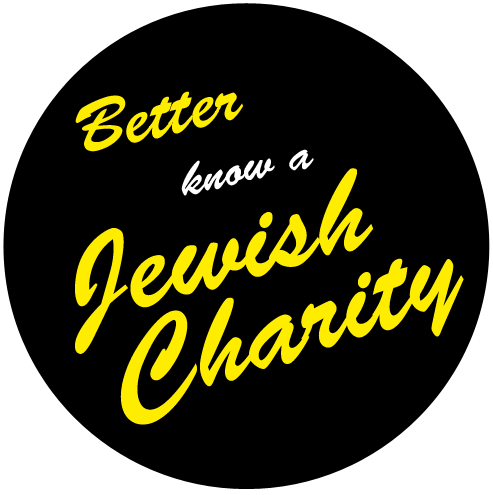Ben Crowne
6 March 2018
Better Know a Jewish Charity
The story of the Memorial Scrolls Trust, and the 1,500+ Czech torah scrolls (“sifrei torah” in Hebrew, singular “sefer torah”) they administer, is a really remarkable one which it is worth going into in some detail (1). Put in the most straightforward of terms, about fifty years ago 1,564 Nazi-looted torah scrolls were brought to the UK by Westminster Synagogue and a local philanthropist; who spent the next few decades restoring the scrolls to be fit for ritual use in synagogues, and then gave them away to Jewish communities all around the world.
The scrolls (2) were collected from the provinces of Bohemia and Moravia during the Nazi occupation of Czechoslovakia, as part of the process of seizures and deportations which formed an early phase of the Holocaust. In 1939 there were some 115,000 Jews in these provinces; of whom maybe 25,000 were able to emigrate before 1941. The overwhelming majority of those who remained – about 80,000 – were murdered in Auschwitz and Treblinka, or died of malnutrition and disease in Theresienstadt. Many of their religious artefacts were gathered in Prague (where they now form the basis of the Jewish Museum’s collection), including almost 1,600 sifrei torah.
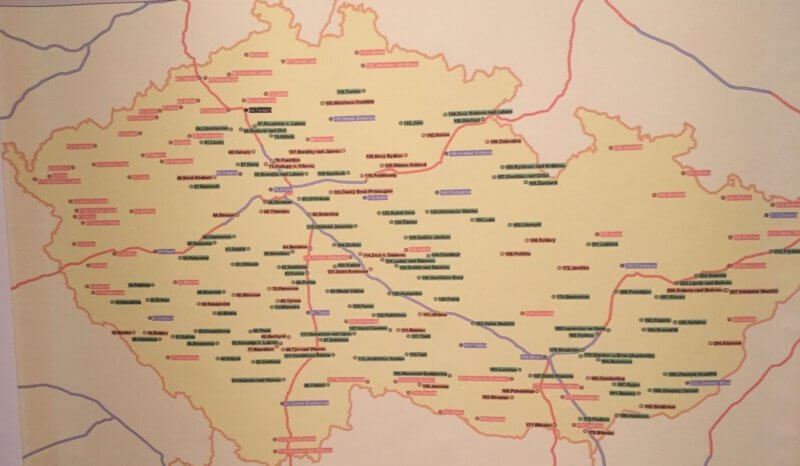
Every green dot on the map is a town which sent sifrei torah to Prague, every orange dot a community which sent other artefacts
After the war, and the communist coup of 1948, the scrolls were stored in an old synagogue, pretty much as they had been collected (3), and without any efforts to preserve their condition. As organic objects – made mostly of parchment and wood – they deteriorated over time, some irreparably from water damage and mould. In the early 1960s the Czechs tried to sell the scrolls to the Israeli government – and although these attempts foundered, word percolated to London where a buyer was found. Ralph Yablon (there are a lot of people involved in the story, but since he insisted on anonymity during his lifetime, it feels only fair to highlight him now), a member of Westminster Synagogue, paid £30,000 (maybe £1-2 million today) for the collection of 1,564 scrolls, sight unseen.
The first batch of scrolls arrived in London on 7 February 1964 – for people looking for historical context, that’s the same day the Beatles began their first US tour – and my estimate is that overnight they doubled the number of sifrei torah in the UK. A newly-written sefer torah will retail for upwards of £20,000 (most of which is the cost of the scribe’s time, they take months to write); so even with substantial restoration costs the collection was a hugely-appealing resource for new and growing Jewish communities around the world.
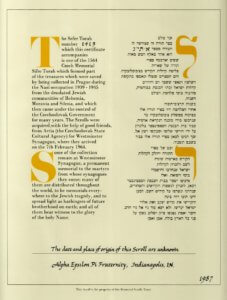
If you have seen something like this on a synagogue wall, but never really looked closely, it is the presentation certificate for a Czech scroll
For pretty much the next thirty years the synagogue was the site of a co-ordinated effort to preserve, restore and distribute the scrolls. There are now more than 1,400 scrolls on permanent loan – the Trust estimates, for example, that they have been used in more than 100,000 bar and bat-mitzvah ceremonies over the last fifty years. It’s hard to think of many other UK-based projects or organisations which have had such a consequential reach across the Jewish world. Last year, one of the scrolls even went back to the Czech Republic, to be used by a new community in the town it originally came from.
Initially, the scrolls were personally owned by Yablon, but early in the restoration process he gifted them to Westminster Synagogue, on condition that they could never be sold (only loaned). Some years later the collection was spun off into a separate Trust, which in recent years has focused on maintaining a small museum, keeping track of the loaned scrolls, education and research. The paperwork from the early days of the distribution process is very colourful, especially rows with the Israeli government and United Synagogue about how rigorous the restoration process was (4), and the analysis provided by the scholar Chimem Abramsky as to the merits of individual claims (sample quote: “a group of impudent schnorrers whose application should be rejected outright”). However, it was not perhaps as methodical as it might have been, and a lot of the Trust’s time these days is spent trying to track down where loaned scrolls ended up.
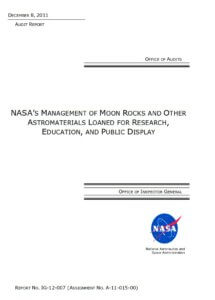
To be fair to the early years of the Trust, it is not like NASA did any better with moon rocks…
The Trust’s story is interesting enough that it even has an interesting accounting component – it’s the first charity in our series to have what are known as “heritage assets”. There is a whole financial reporting standard (FRS 30) devoted to their treatment – these are items which are owned primarily for their “contribution to knowledge and culture” rather than for economic use – and in many cases (like the scrolls) effectively have no monetary value as they can’t be bought or sold. And this is one of those more-frequent-than-you-might-think occasions where the abstractions of accountancy actually capture something essential…
A sefer torah isn’t just a physical object, its significance depends on the thought-process behind its construction and on-going use – in academic language, it has noetic content (5). The process of production has to be done by hand, and from the technical perspective of halacha – religious law – the writing of a sefer torah requires conscious intention on the part of the scribe. It can’t, for example, be printed, and attempts over the centuries to mechanise the process have received at best minority support from legal authorities. In the early days of the printing press, some rabbis permitted scrolls to be produced one sheet at a time using movable type, on the basis that the typesetting process was akin to writing and required intention. More recently, proposals to use a silk-screen process to radically reduce time and costs have similarly met with little support.
But there’s a paradox at work here, in that from an aesthetic perspective, the most highly-valued scrolls are generally those which look as manufactured as possible. Because a sefer torah might be read from on any given day by someone who has never used that scroll before, the qualities sought are clear, regular and precise lettering; perfect alignment and kerning, and a minimum of individual flair. The ideal scribe, then, is totally present during the writing process, but invisible in the final product (6).
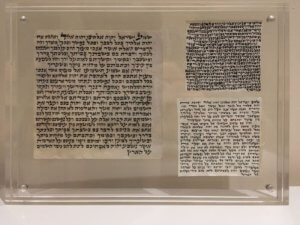
I don’t have multiple sifrei torah to hand for demonstration purposes, but here are three mezuzah scrolls to give an idea of the range of quality which a scribe could produce. Any sefer torah would look pretty much the same as the parchment on the left
This dual nature, I think, helps to account for one of the most striking features of the scrolls – the huge range of significance that they enjoy in individual communities. Many synagogues have sections of their websites dedicated to their scroll and its provenance (this is the main “ask” which the Trust has these days for active communities), some participate in memorial or reunion events, or even hold their own. In the US in particular, a number of congregations hold a special service every year on the anniversary of the deportation from the town their scroll came from.
Other synagogues are barely aware that their scroll has any particular historic importance. Interestingly, it tends to be Orthodox synagogues – especially those in the UK – who are more likely to treat their Czech scroll like any other. In at least a couple of cases, Czech scrolls which have deteriorated and aren’t suitable for ritual use have been buried in a cemetery by the local community. This is particularly upsetting to the Trust, quite apart from the legalities, as they could still use such a scroll for display or research, or gift it to another museum or a private collection (the Queen’s library in Windsor Castle has one).
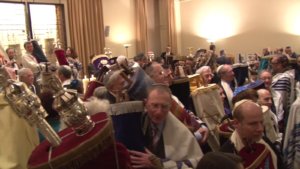
Here’s a photo from the UK’s 50th anniversary commemoration in 2014
One of the things which is really apparent from a visit to the Trust’s Museum – they still have about 100 scrolls, most of them too badly damaged to be repaired, or even opened – is the variety on display. Most modern, Ashkenazi, sifrei torah are basically identical –the parchment panels come from only a handful of manufacturers and are a uniform height and colour, there is now a standardised, line-by-line layout of the text (which assists with e.g. computerised error-checking). And even when there is variance, you can expect them to be basically the same height and weight, with wooden staves and rollers and a minimum of decoration.
The Czech scrolls, by contrast, showcase a wide range of materials and designs. Some have metallic staves (Orthodox law only allows wooden staves, in accordance with the verse “it is a tree of life to those who grasp it”). Handles might be of a precious metal (there is one beautiful scroll with plain silver handles, another with ornate astrological patterns set out in gold), or ivory when that was fashionable. A traditional practice in parts of Bohemia was to commission a silk banner to wrap a child for circumcision; and then re-use that banner as the wrapper for a sefer torah – the Trust has one of the world’s largest collection of these. More esoterically, the chronological and geographic range of the scrolls is a great resource for palaeographical research into handwriting and local customs. For example, the scrolls have provided evidence for a hitherto-unknown practice, probably from the 17th century, to occasionally insert a floating diamond above particular words of significance.
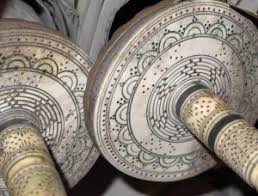
The museum catalogue refers to this euphemistically as “bone and wood”
The Trust itself is a good example of an often-maligned group: the small, single-purpose charity. Its expenditure over the last five years has been about £60k annually – a number that’s expected to drop significantly now that a more active set of trustees have replaced a full-time employee in the day-to-day running of the organisation. When I met the chair of trustees (who, full disclosure, is my third cousin, twice-removed – although I don’t think we had previously met), he was very much in favour of a charity run entirely by volunteers. This is the same sort of model and mentality which long-time readers will remember from an NVCO report all the way back in BKaJC – C, of intrinsic resistance to spending charity money on salaries if volunteer resources are available.
I have said my piece before on small Jewish charities, and doubtless we will get back to it again later in the series; but the Scrolls Trust is a great example of how and when a small charity works as an operating model. It has a clear mission, a limited scope, a distinct operating model, strong formal and informal relationships with other organisations (in particular Westminster Synagogue, their landlord), and a unique story and perspective. It’s hard to see that surviving in the same way if the Trust had remained part of Westminster Synagogue, or – for the sake of argument – if it were to be subsumed into one of the numerous charities focused on the Holocaust or European Jewish history.
This I think is the crucial point – if a charity has a unique purpose, or draws support from a specific constituency, or operates with a distinctive model, then arguments about “duplication” are less relevant. While I do struggle to see the need for fifteen separate charities to run geographically-contiguous eruvs across North London; or the twenty thirty-plus Israel-advocacy organisations that seem to be active at any one time, the Memorial Scrolls Trust seems to be doing just fine.
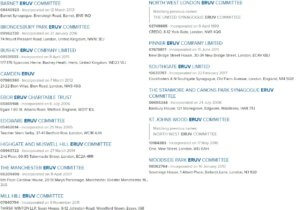
Ok, I exaggerate… fourteen
Although it’s only tangentially related, this is such a good opportunity to tell one of my favourite sefer torah stories that I want to close with it. Years back, the slowly-dying community of Llanelli, in South Wales, hosted a chassidic group one summertime. Happy at the prospect of their synagogue in regular use, the residents gave the visitors free rein, just doing a quick inventory when they departed. The synagogue fell into disuse, and a scroll was passed on to the Cambridge community; who soon discovered that one third of the panels which made up the scroll were missing! Most modern scrolls (as noted above) are a uniform size and shape, so the visitors had clearly surreptitiously removed a range of panels in order to assemble a new scroll at a reduced price. Due to the age and non-standard size of this particular scroll, however, this was not possible – and the panels were ultimately recovered from the store of a recently-deceased scribe in Golders Green. It is unclear whether divine wrath was responsible for the scribe’s death, but I do not recommend relying on it as an alternative to insurance…
(1) For more information, the Trust has a press pack here (PDF), a fuller official history (£20 on their website), and their museum in Westminster Synagogue is definitely worth visiting (by appointment, email info@memorialscrollstrust.org).
(2) A quick reminder/explainer: a sefer torah contains the Hebrew text of the five Books of Moses (Genesis though Deuteronomy) – about 80,000 words. It is a single continuous scroll, made of individual parchment panels which are stitched together. The scroll is then fastened to two wooden staves, and covered either with a fabric (in most Ashkenazi traditions) or placed in a container (in many Sephardic and Eastern traditions). It is used on sabbaths, festivals and some weekdays; and read from beginning to end on a one- or three-year cycle.
(3) For example, when the scrolls arrived in London in 1964 some were found to have bloodstains on them; one had been held together inside a corset, all had been left in a damp hall for the better part of twenty years.
(4) It is all in the book…
(5) Before the phenomenologists get too upset – yes, everything has noetic content…
(6) This may sound familiar to readers of Walter Benjamin, John Berger &c. The distinction here is that a sefer torah isn’t a reproduction of an original work, except in an extremely abstract sense… it’s a work of craft, rather than art.
Copyright © 2018 Better Know a Jewish Charity, All rights reserved.
Click here to read the original article and sign up for future issues of Better Know a Jewish Charity
Share this Post

